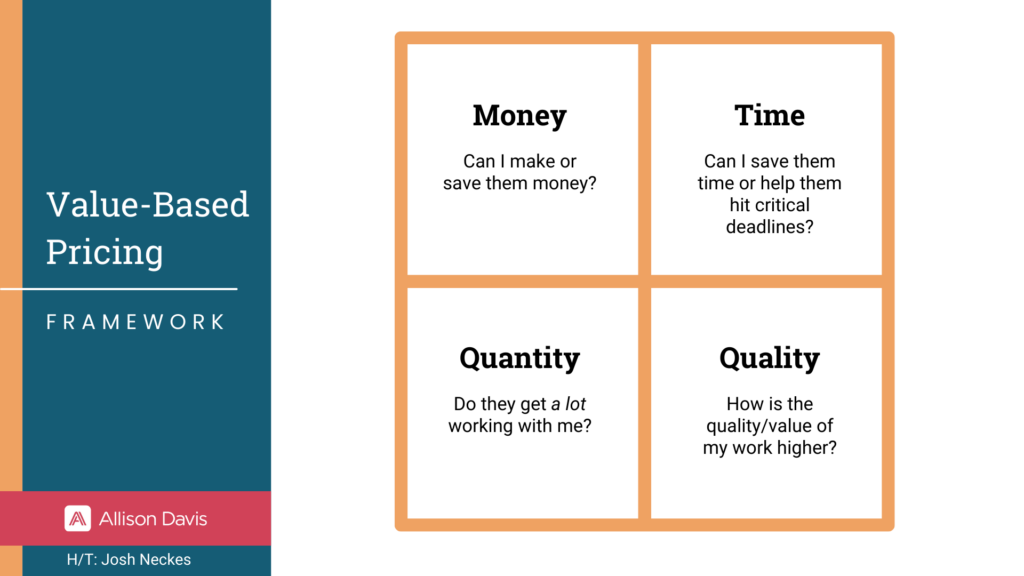How To Embrace Value-Based Pricing
Posted on December 1st, 2023 to Uncategorized
Value-based pricing can be confusing and challenging to nail down for consultants and service providers.
As a subject-matter expert and founder of your company, you know how much value you bring to each and every client engagement, and you want to charge accordingly.
But putting a number on your work can bring up hesitations for many reasons, not least of which is the stories we tell ourselves about money.
A lot of these hesitations came up in a recent Sales Roundtable I hosted on pricing, which led to many questions about value-based pricing.
So, in this blog post, I’ll guide you through how to know if value-based pricing is a suitable model for you, how to position yourself to your leads, and how to overcome any challenges that arise during sales calls.
Plus, I’ll give you a framework and exercise to put into practice with examples from my business.
I promised a deeper dive, so here we go!
Understanding Value-Based Pricing
First, let’s define the term value-based pricing.
Simply put, it’s a predetermined fee based on the anticipated value the client will receive rather than just time spent or deliverables provided.
It’s different from hourly rates, retainers, or commission models – and anticipated value is the key here.
You don’t have to, and likely cannot, guarantee an outcome.
For subject-matter experts and B2B service providers, value-based pricing does away with trading time for money and focuses on the value received by the client.
Because of this, it can be an ideal pricing model for subject-matter experts and consultants, and I’ll explain why in the next section.
Are You a Candidate for Value-Based Pricing?
Let’s take a look at three key components that must be in place to justify a value-based pricing model.
Defined Deliverable
You must have a clearly-defined deliverable, but it can be tricky for consultants to narrow their work to a few handovers.
Because your services are wide-ranging and aren’t as tangible as a widget, it’s key to present a well-understood scope of work.
High-Value Service
The value you deliver should be significant. I advise clients to think about an outcome at least 5 to 10 times what they’re charging for the work. Read on for a real-life example from my business, including numbers.
Subject-Matter Expertise
Are your clients incapable of doing this work with existing in-house staff? Will they benefit from your talent, knowledge, connections or resources — intangibles that they would not have without you?
To command value-based pricing, you need to be a recognized expert in your field, and bring unique skills or knowledge that your clients don’t have internally.
Now that we’ve covered some qualifiers, let’s move on to how to position your services.
Market Understanding and Competitive Positioning
If you’re confident that you’re ready to move to the value-based pricing model, knowing the market is critical.
I recommend researching what your competitors or larger firms are charging for similar services.
This knowledge can be a powerful tool when you present your rates in a sales call.
The consultants I work with compete with firms like Accenture and McKinsey, and my creative founders are up against more prominent agencies of record.
These biggies all have one thing in common. More overhead.
The bigger consultancies will cost more, so you can show your clients how they’re getting a steal on working with you even though it might be a higher price than what you’ve charged thus far.
You want to understand the market, where your value-based pricing falls on the spectrum, and how it fits into the greater picture. There’s probably a pretty good story for you to tell about why it makes sense for them.
Overcoming Challenges in Value-Based Pricing
While value-based pricing with a big round number sounds great, founders commonly face some challenges implementing it because it requires them to stand strong in their price.
Now, there’s no doubt that you deliver immense value to your customers. You have the track record to prove it, and you have a keen awareness of what the work will entail.
So, on sales calls, you must embody your expertise and stand firm in your pricing while showing your client that you empathize with them and understand their priorities.
The complexity of these factors can be overwhelming, leaving many needing help figuring out where to begin.
So, next up, I want to give you an exercise to get you thinking about the value you provide so that you can confidently present your pricing.
Practical Exercise for Value-Based Pricing
For this exercise, I’m going to refer to a framework I first encountered from Josh Neckes, a fellow instructor at IndeCollective, that I found to be really useful for assessing value.

As subject-matter experts and consultants, we offer value in many ways, but the four most consistent are money, time, quantity and quality.
For this exercise, I encourage you to take a pen and paper and evaluate your service in these four categories.
Ask yourself questions like:
1. How do I save or make money for my clients?
Think about how you help your clients make or save money — it doesn’t have to be through sales.
For example, if you’re performing work inside an organization that saves them the cost of hiring a full-time employee, you’re saving them money in the long run.
2. How do I save them time?
Time is money, as they say. How are you saving your clients time with your services? Can you uncover areas where they’ve been wasting time in their businesses that you can take off their plate?
3. Do they get a lot working with me?
For this question, it’s imperative to dial in how the quality of your work is higher and why it matters to your buyer.
I’ll say it again, at the risk of repeating myself — if someone is in charge of making sure that a particular campaign or project has a high-level outcome and they don’t perceive they have the expertise or the time and you can show up with both, you have a strong value proposition.
And the last one is quantity.
4. How does the quantity and quality of my work stand out?
For this question, it’s crucial to emphasize that this isn’t merely a matter of perception; it’s about actual execution.
When you assess what your clients will receive and, more importantly, when you deliver your proposal, the key question is whether it resonates positively with them.
Does the scope of work you present convey a sense of abundance?
In 2023, I’ve observed that buyers often grapple with apprehension and fear of making costly mistakes, leading to prolonged decision-making processes.
You may have seen it in your business, too.
This hesitation stems from uncertainty and anxiety. Sometimes, the assurance of ample support and resources provides comfort in such situations.
So, do your clients perceive that they’re receiving substantial value?
It’s important to tread carefully here; you don’t want to overextend yourself, but you want to position your work in a way that communicates the inherent abundance of what you offer.
I can assure you that value exists, but it’s a matter of how you frame it for your clients.
Let’s take a look at my business as an example.
Real-Life Application and Case Study
There’s a reason I don’t post my prices on my website, and it’s not because I’m trying to be a jerk and withhold information to get people on a sales call.
Instead, I want clients to fully understand what’s at stake for the value of the investment they’re making.
On a sales call, I can articulate what I do and why I’m worth the investment, running through many of the points we touched on above.
Otherwise, I run the risk of potential clients seeing my price and clicking away because they make their assumptions about my service.
So, let’s apply the grid to my business.
Money
My starting price is between $15,000 and $20,000 for my Sales Playbook engagement.
From experience, I know that working with me can represent up to a 30% increase in sales revenue right off the bat. For a business with an annual revenue of $300,000, that’s an additional $90,000 in year one.
So, trading $20,000 for a potential $90,000 gain? That’s value-based pricing in action!
As I mentioned above, I have to clearly and convincingly communicate the how and why of this increase when I speak with clients.
I have to show them the way forward and articulate, based on my experience and past success with other clients, how I’ll help them get there.
Time
Clients often turn to my services when they find themselves investing time and effort into sales without seeing commensurate results. Or, when they’re ready to tackle larger, more complex engagements.
By partnering with me, they streamline their efforts, ensuring they don’t waste precious time on strategies that don’t yield desired outcomes (hello, cold calling and endless posting on LinkedIn with no leads to show for it).
In addition, I can demonstrate a solid track record of shortening sales cycles, reducing the waiting period between proposal submission and receiving responses.
By providing clients with a sales playbook equipped with proven tactics tailored to their unique business model and objectives, I not only save them valuable time but also spare them the frustration that often comes with spinning their wheels.
Quantity
I’m not your average sales consultant. Nor do I share a canned, one-size-fits-all training and leave you to figure out the rest on your own.
As my clients apply the new strategies and skills they’re learning, I’m available to answer questions and help them close deals in real time — because that’s what it takes.
In other words, I’m around to provide a lot of tailored support to my clients from the beginning of the engagement to the end — providing that feeling of abundance from a value-based pricing perspective.
Quality
There are a lot of talented sales consultants, just like there are a lot of qualified service providers out in the world like you.
That means you have to lean into what makes your expertise and experience unique.
I specifically work with subject-matter experts who sell premium B2B services to complex organizations, and I know the business inside and out. It’s what I did in my career, and it’s vastly different from selling moderately-priced services to consumers or even to other entrepreneurs.
As a result, I can guarantee my clients a higher quality of information and results.
My services and counsel are highly applicable and immediately useful — no wasting time and no fluff.
So that’s how my quality is higher than some of my competition.
The Key to Value-Based Pricing: Understand the Value You Provide
We’ve just scratched the surface of value-based pricing, but I hope this gives you a solid starting point.
It’s not just about charging more; it’s about understanding and communicating the value you bring.
A project that might seem simple, obvious or accessible to you may mean a big win to your client. So don’t downplay your value because the work is second nature to you.
Your work and contributions could be worth hundreds of thousands — even millions of dollars to a client — so charge accordingly.
Do you have questions or thoughts? Hit me up! I work with my clients on value-based pricing as part of the Sales Playbook — read more about it here.





